Physical Address
304 North Cardinal St.
Dorchester Center, MA 02124
The peroneal nerves described in this chapter, which are also known as fibular nerves, are comprised of the common peroneal nerve (CPN), superficial peroneal nerve (SPN), and deep peroneal nerve (DPN) ( Fig. 27.1 ). The CPN (also known as the common fibular nerve, external popliteal nerve, and lateral popliteal nerve) is a branch of the sciatic nerve that separates from the tibial nerve just cephalad to the popliteal fossa ( Fig. 27.2 ). Given its predominantly superficial trajectory, it is the most commonly injured lower extremity nerve and a typical focal neuropathy of the lower extremity, with the fibular head being the most common site of pathology in CPN neuropathy ( Fig. 27.3 ).

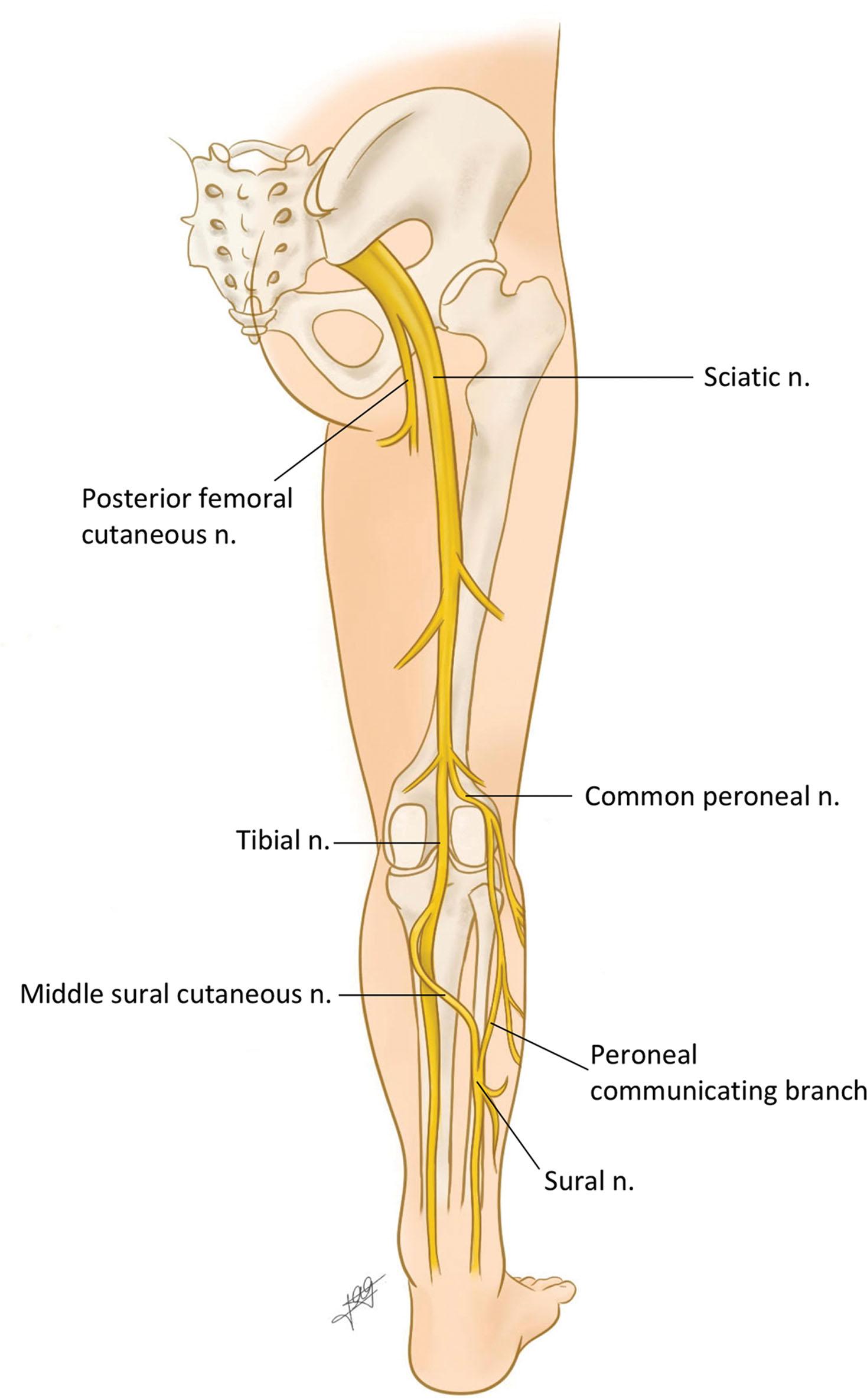
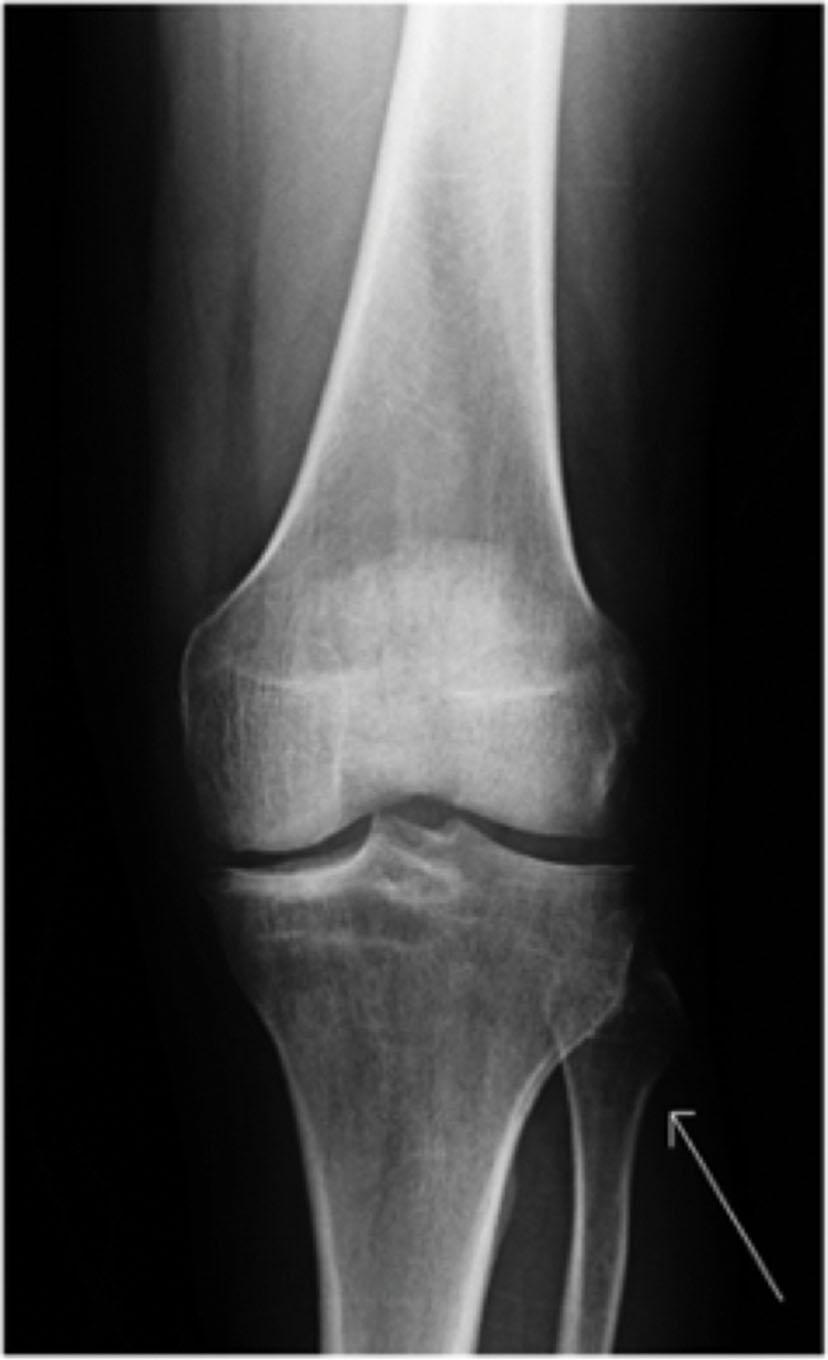
Compression injury of the CPN is caused by a myriad of external mechanisms including iatrogenic causes such as tight-fitting casts, lithotomy position, and anesthetic positioning palsy. Peroneal palsy can also be induced by the improper use of pneumatic intermittent compression stockings if these are not carefully placed because this can lead to pressure on the peroneal nerve directly below the fibular head. Trauma, as one of the major causes of CPN compression, can be due to open and blunt force injuries of the lateral knee and open or arthroscopic knee surgery that compromises the integrity of the nerve. Although infrequent, missile injuries also affect the peroneal nerve integrity, and are usually caused by low-velocity missiles. Tibial plateau fractures represent approximately 1% of CPN injuries. CPN palsy after total knee arthroplasty is also relatively rare, with estimates of its incidence ranging from 0.01% to 4.3%. The CPN is also one of the most commonly involved nerves in complex regional pain syndrome (CRPS) of the foot and ankle region.
The Greek adjective “peroneal” is now replaced by the Latin “fibular” for various muscles, vessels, nerves, and structures, for example: common fibular nerve instead of common peroneal nerve and inferior fibular retinaculum instead of inferior peroneal retinaculum. To ease in the new terminology for those used to working from older texts, the term peroneal is included, (e.g., deep fibular [peroneal] nerve or deep peroneal [fibular] nerve). This terminology conforms to the International Anatomical Terminology—Terminologia Anatomica—created in 1988 by the Federative Committee on Anatomical Terminology and approved by the 56 Member Associations of the International Federation of Associations of Anatomists.
As with many peripheral nerve entrapments, symptoms differ depending on the origin and extent of the problem. When there is injury to the CPN or DPN with the subsequent inability to dorsiflex and evert, patients can frequently present with “foot drop.” Foot drop causes a “slapping” gait, toe dragging, problems with walking and climbing stairs, and frequent falling, as well as sensory changes in the lateral aspect of the leg and dorsum of the foot and toes. In many cases, the patient will compensate for their foot-dragging by exaggerating hip abduction to allow for increased clearance of their foot.
Another cause of CPN neuropathy is prolonged extrinsic pressure. This can be discovered postoperatively in patients who had been in the lateral decubitus or lithotomy position during surgery. The CPN may be susceptible to damage in patients who have lost a significant amount of weight, particularly if they are confined to bed where the natural position of the leg is in external rotation with knees flexed. Another classic form of injury, known as “grape-picker palsy,” may happen in a professional context. It is an entrapment neuropathy in which the CPN gets compressed at the level of the neck of the fibula. CPN compression can also present with paresthesias, followed by loss of sensation, tingling, numbness, or burning on the lateral lower leg, down to the top of the foot. When pain is present, it is typically exacerbated by physical activities, such as walking, running, riding a bicycle, jogging, or squatting.
Very often underdiagnosed, SPN entrapment is a cause of anterolateral leg pain. Similar to the sural nerve, the superficial course of the SPN makes it susceptible to injury, and it may be compressed at the lateral calf or ankle. SPN entrapment was first described by Henry in 1945 as “mononeuralgia in the superficial peroneal nerve. ” The SPN, also known as the musculocutaneous nerve of the leg, is a commonly injured nerve during ankle surgery (especially after ankle arthroscopy, with an incidence of 1.92%–5.4%), after an ankle fracture, or after injury as a result of participation in sports. Entrapment typically occurs at the area where the nerve exits the crural fascia because of a thickened fascial tunnel, a defect in the fascia with muscle herniation, or soft tissue mass. SPN compression is characterized by pain in the distal anterolateral calf, ankle, and dorsum of the foot, with or without paresthesia. The pain can be described as burning in the distribution of the nerve over the lateral calf and dorsum of the foot, at times associated with sensory abnormality. The pain may be aggravated by plantar flexion, a movement that stretches the SPN, which may make pressing the accelerator or brake quite difficult while driving. SPN dysfunction can result in weakness of foot eversion as well as sensory changes in the lateral leg and dorsum of the foot and toes. As with CPN dysfunction, pain typically worsens with physical activity.
DPN, also referred to as deep fibular nerve, entrapment was originally described by Gruber in 1877 and then by Kopell and Thompson in 1963. Marinacci later termed one site of DPN compression of the dorsum of the foot as the anterior tarsal tunnel (ATT) and proposed an electrodiagnostic technique to assist in diagnosis. The terminology can be confusing; some earlier authors do not distinguish between the DPN and its branches (the medial branch of the DPN [MBDPN] is particularly likely to be termed “DPN”), and also refer to entrapment of one of the branches as “ATT syndrome” or “partial ATT syndrome.” Compression of the DPN and either of its branches may occur as it passes through the ATT, which is defined by the inferior extensor retinaculum superficially and the talonavicular joint capsule deeply. Other structures passing through this tunnel include the dorsalis pedis artery and vein and the tendons of the extensor hallucis longus (EHL), the tibialis anterior, the extensor digitorum longus, and the peroneus tertius. The relationship between recurrent ankle sprain and DPN entrapment is of particular interest, because the former is such a common injury and because postsprain pain ( sinus tarsi syndrome) and joint instability are so frequent in the clinical setting. Wearing high-heeled or tight supportive shoes, sitting for a prolonged period of time with the feet plantar flexed, prolonged squatting, and pressure to the lateral knee and ankle during deep sleep can also induce neuropathy of this nerve.
The DPN may also be affected by medical conditions such as diabetes mellitus, lower motor neuron disease, infectious disorders, toxin exposure, and ischemia. CPN is the most common low limb mononeuropathy in athletes, most likely due to compression by the peroneal longus (PL) muscle (also known as the fibularis longus muscle). Space-occupying lesions such as intraneural ganglion cysts, scar tissue after surgery of the lateral knee, vascular aneurysms, or lipomas can also compress the CPN.
Lastly, DPN neuropathy is often produced by acute or repetitive strikes at multiple points in the leg, ankle, and foot, which can lead to perineural adhesions and decreased mobility of the nerve. The location of the injury dictates the type of pain with which the patient may present. Symptoms may present with vague pain, a burning sensation, or a cramp over the dorsum of the foot, sometimes involving the web space between the first and second toes. These symptoms tend to increase over time and are often generalized, tending to progress to increased pain and disability. Shoes, if tolerated at all, will exacerbate the complaints, and an antalgic gait pattern may be observed. A detailed history of symptom onset, trauma, and recent shoe or activity changes can be helpful for diagnosis. In addition to symptom exacerbation by activity and plantar flexion of the foot, pain sufficient to wake the patient from sleep is not uncommon and is probably due to a sleep position that stretches the DPN or one of its branches ( Table 27.1 ).
| Etiology | Description |
|---|---|
| Compression |
|
| Section |
|
| Traction |
|
| Ischemia |
|
The CPN is a mixed nerve that originates as the continuation of the lateral terminal division of the sciatic nerve and is the smallest of its two main branches; it is estimated to be approximately half the size of the other branch, the tibial nerve. It is made up of the L4, L5, S1 and S2 roots and functions as a motor and sensory source to the lower leg, dorsum of the foot, and toes. It has a bifurcation of origin typically located in the popliteal fossa at the junction of the upper two thirds and lower third of the posterior thigh, where it gives off three branches: the lateral sural cutaneous nerve (lateral cutaneous nerve of the calf), which supplies sensation to the upper lateral calf; the sural communicating branch, which travels posteriorly to join the medial sural cutaneous nerve to form the sural nerve; and the nerve to the short head of the biceps femoris (BF) muscle (see Fig. 27.2 and Fig. 27.4 ).
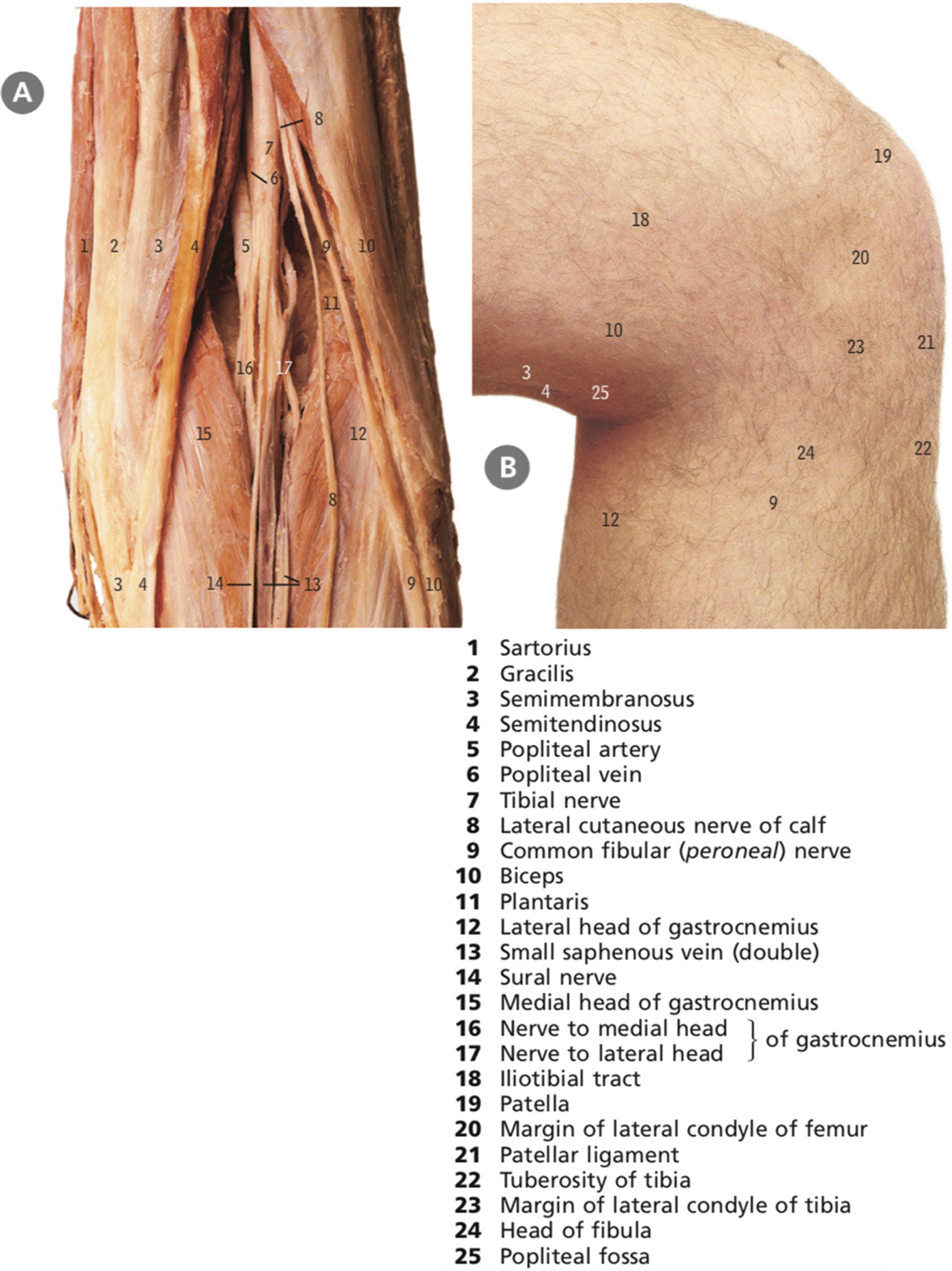
The CPN is the only palpable major nerve of the lower limb, and it can be felt as it passes downward and forward across the neck of the fibula. It follows the medial edge of the BF to the lateral popliteal fossa to the fibular head, where it redirects itself on a downward course to wind laterally around the neck of the fibula between the two heads of the PL muscle, dividing into its terminal branches. The CPN gives off some muscular branches, as well. All of the branches cross the intermuscular septum from the lateral to the anterior compartment. Most commonly, the very proximal muscular branch (to the tibialis anterior muscle) pierces the septum directly, while the main nerve and remaining muscular branches traverse an osteofibrous hiatus between the septum and the fibula. It continues into the foot between the two insertions of the PL as the SPN, which is lateral, and the DPN, which is medial ( Figs. 27.5 and 27.6 ). Additionally, there is a variant called the accessory peroneal nerve (accessory fibular nerve) that branches from the SPN underneath the peroneus brevis (PB) muscle (fibularis brevis muscle), traveling to the foot, posterior to the lateral malleolus. Published literature has also described the CPN separating from tibial nerve proximal to the piriformis and passing between the heads of the piriformis muscles, with the tibial nerve passing inferiorly.
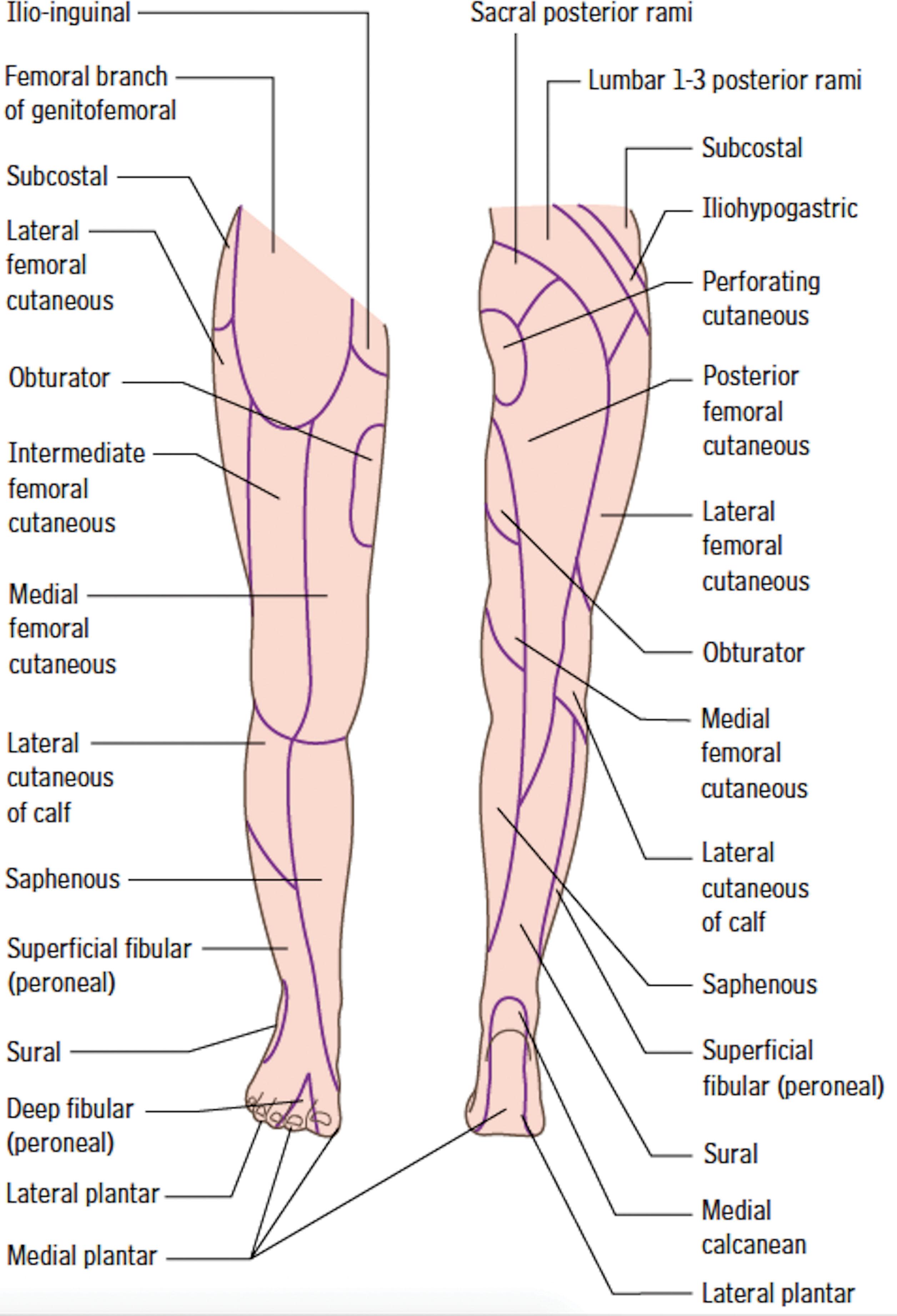
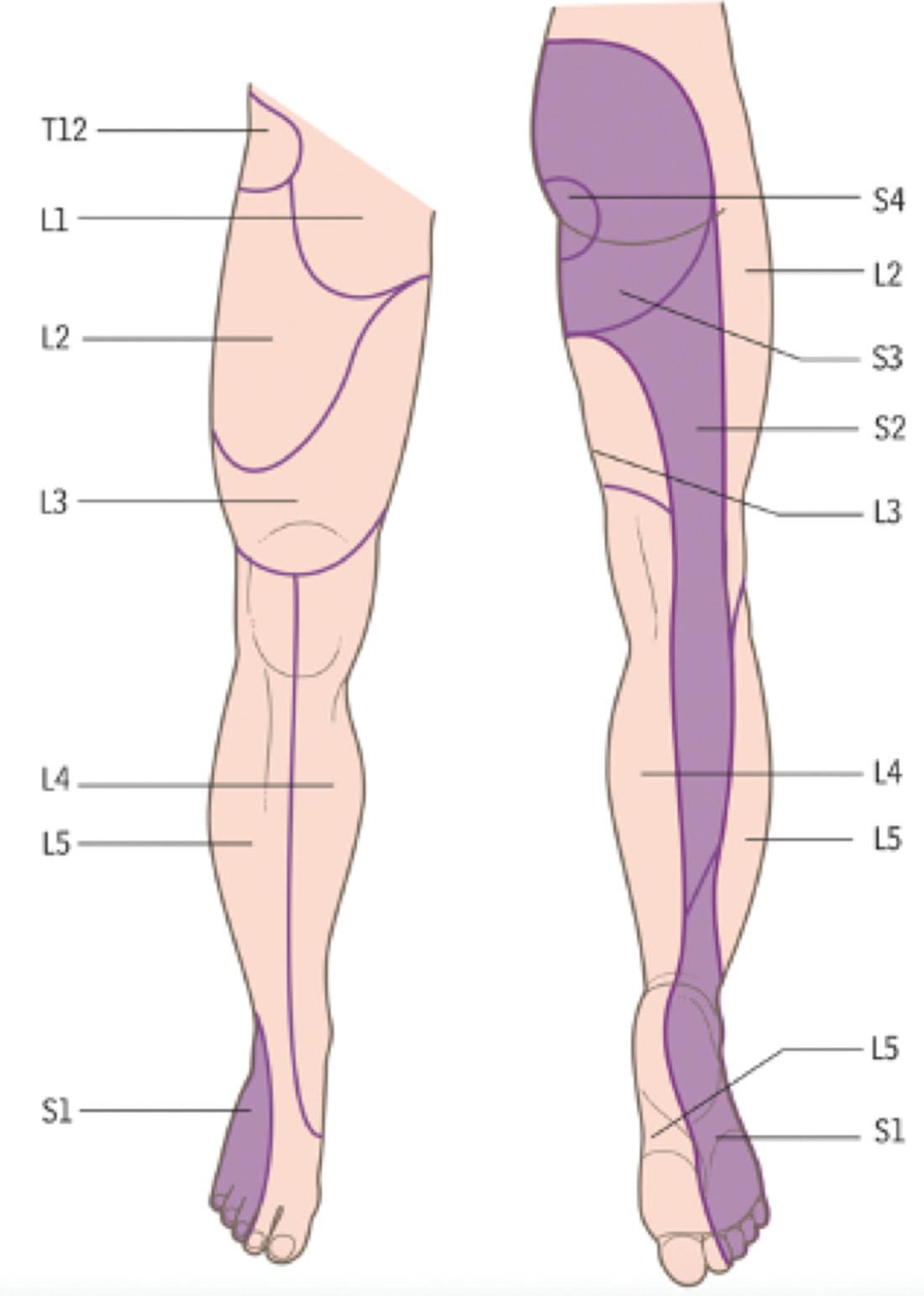
The SPN, formerly known as the musculocutaneous nerve of the leg, is one of the terminal branches of the CPN and begins at its bifurcation near the proximal fibula. It passes deep to the PL, providing motor innervation to the PL, initially coursing between the PL and the fibula and then between the PL and PB, and then on to the distal leg. The SPN or its branches pierce the fascia by way of a tunnel (the peroneal tunnel) 3 to 18 cm proximal to the lateral malleolus. It then divides into its terminal branches, the intermediate dorsal cutaneous nerve and the medial dorsal cutaneous nerve ( Fig. 27.7 ). Anatomic studies have shown that the nerve may travel in the anterior compartment in 14% to 17% of patients. The SPN provides sensation to the distal two thirds of the lateral leg and most of the dorsum of the foot and supplies the PL and PB muscles, which provide plantar flexion and eversion to the foot. There have been anatomical variations described in the literature that put the nerve at risk for trauma during fasciotomies, among other surgical techniques.
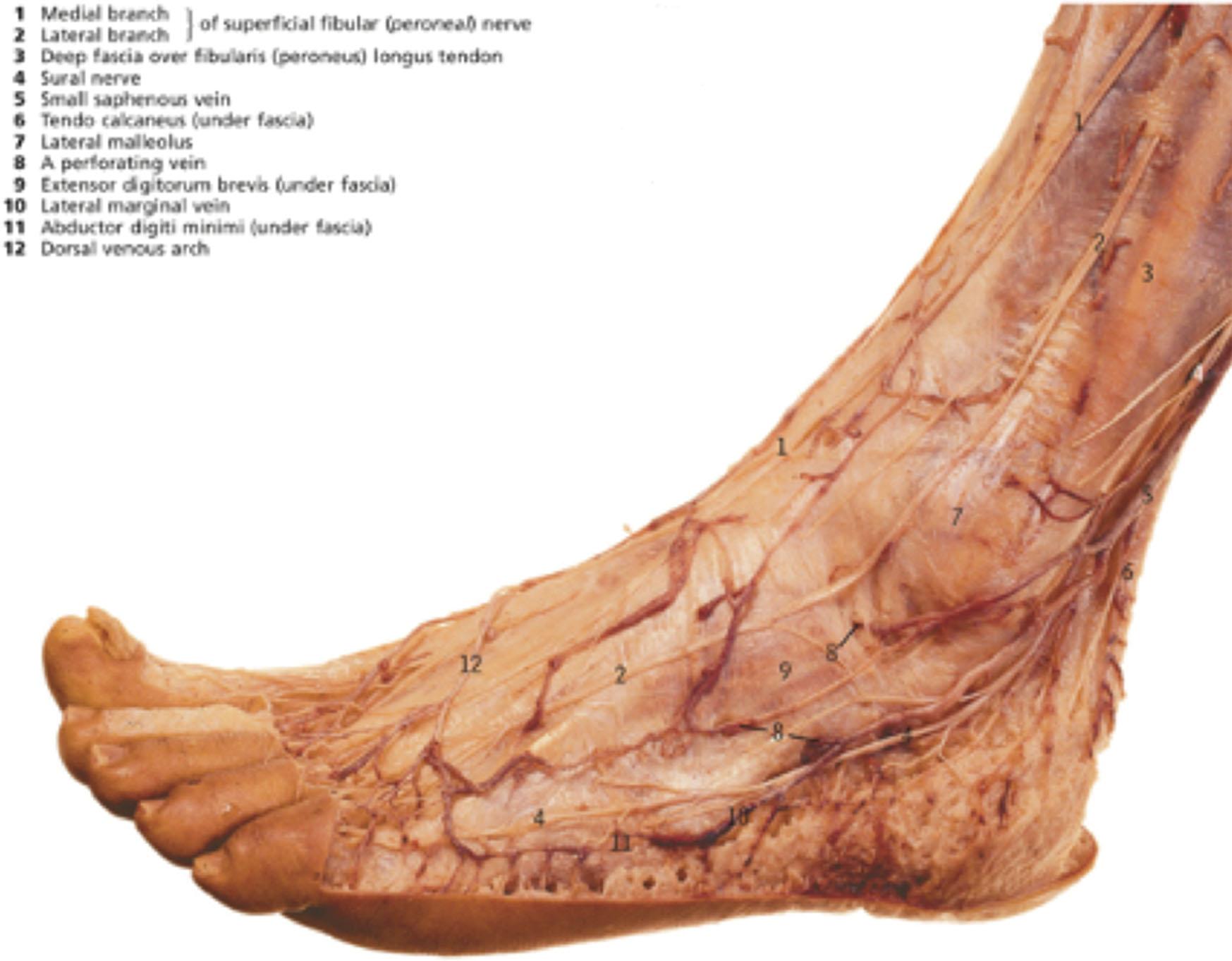
The DPN, formerly known as the anterior tibial nerve, is also one of the major divisions of the CPN and originates between the two insertions of the peroneus longus muscle. The point of bifurcation is located near the head of the fibula, where the CPN enters an osteofibrous hiatus or opening within the intermuscular septum, passing from the lateral to the anterior compartment and around the fibula, splitting into the SPN, the DPN, and anterior recurrent peroneal nerve (ARPN). As the names imply, the SPN stays relatively superficial along the lateral portion of the calf, the DPN dives more deeply and anteriorly, and the ARPN travels cephalad to the knee ( Fig. 27.8 ). In the lower leg, the DPN runs between the tibialis anterior and the EHL 5 cm above the ankle mortise, and then sends motor branches to all of the anterior compartment muscles, which include the tibialis anterior, extensor digitorum longus (EDL), EHL, PL, and PB. Under the superior extensor retinaculum, approximately 1 cm proximal to the ankle joint, the nerve divides into a medial and a lateral branch. The lateral branch courses deep to the inferior extensor retinaculum to provide motor innervation to the extensor digitorum brevis and sensation to the ankle joint and the lateral tarsal joints. The medial branch courses with the dorsalis pedis artery under the inferior extensor retinaculum and provides sensation to the first web space ( Fig. 27.9 ). The main trunk of the DPN accompanies the anterior tibial artery on the interosseous membrane and travels beneath the tendon of the EHL in the distal third of the leg and then under the extensor retinaculum at the anterior ankle. The DPN usually divides approximately 1.5 cm proximal to the ankle joint into a lateral branch of the DPN (LBDPN) and an MBDPN. The MBDPN is primarily sensory but does supply motor innervation to the first and second interosseous muscles. It runs with the dorsalis pedis artery on the top of the foot and then under the extensor hallucis brevis tendon to lie on the first interosseous muscle, between the first and second metatarsal bones. The MBDPN supplies the first metatarsophalangeal joint and first dorsal interosseous muscle and ends in the skin between the first and second toes. Distally, one third of the population presents with the MBDPN communicated with the medial dorsal cutaneous nerve, a branch of the SPN. As the LBDPN makes its way across the foot, it gathers sensory fibers from the ankle joint and from the sinus tarsi. It usually provides motor supply to the extensor digitorum brevis, though additional innervation of this muscle may be provided by the accessory peroneal nerve, a branch of the SPN. The LBDPN terminates as interosseous nerves, which innervate the lateral tarsometatarsal joints and lesser digits ( Table 27.2 ).
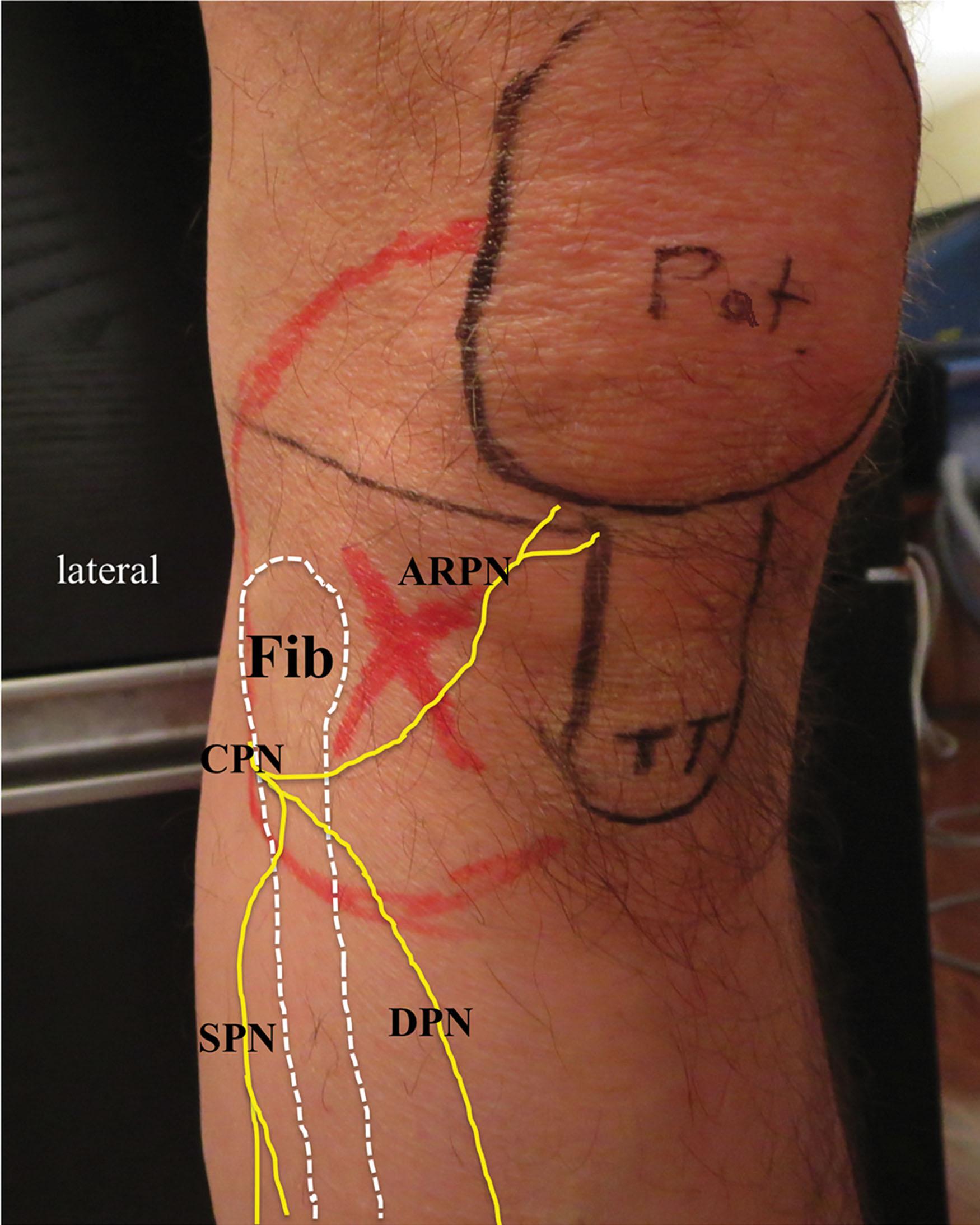
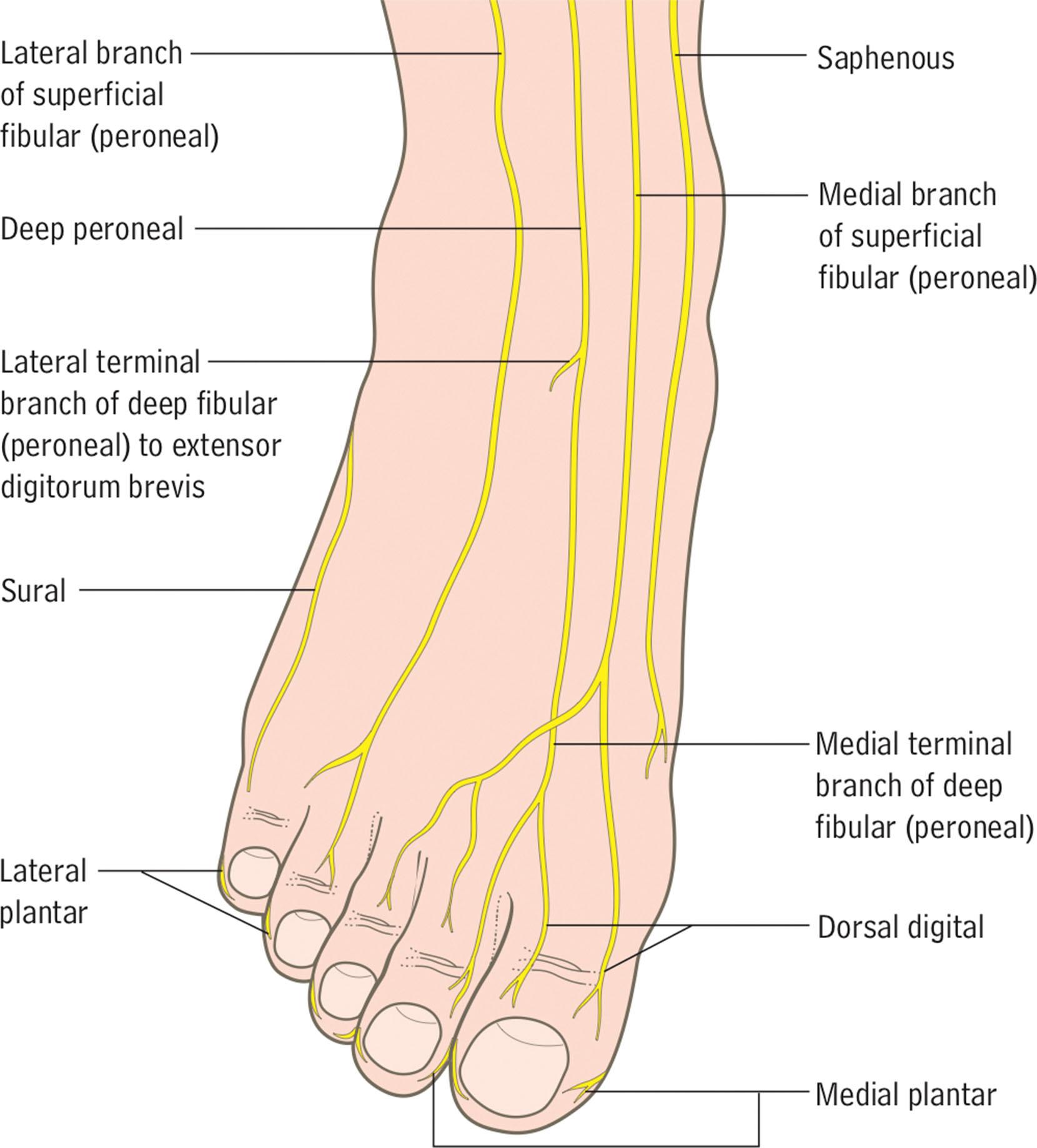
| Origin | L4, L5, S1, S2 roots; it originates from the trunk of the sciatica nerve at the level of the popliteal fossa in its uppermost vertex. | |
| Trajectory | It travels downwards and laterally in the popliteal fossa, facing the tibial nerve medially and the upper part of the biceps femoris muscle laterally, going around its fibular insertion from below. It then travels above the proximal insertion of the lateral head of the gastrocnemius muscle, where it gives off the lateral sural cutaneous nerve . | |
| Terminal branches | The CPN goes around the head of the fibula, between the tendon of the biceps femoris above and the lateral head of the G below. It then goes through the crural intermuscular septum in order to place itself on the deep face of the peroneus longus muscle and to split into the SPN , which is lateral, and the DPN , which is medial. | |
| SPN collateral and terminal branches | Perforating through the anterior intermuscular aponeurosis at the inferior third of the leg, the SPN gives off the collateral branches for the peroneus longus and brevis muscles and the cutaneous branches for the lateral malleolus. The SPN then splits into two terminal branches in front of the extensor retinaculum: a medial branch and a branch that heads towards the first interosseous space. It then splits into two dorsal collateral digital nerves: lateral of the hallux and medial of the second toe. The lateral branch gives off several dorsal digital nerves: lateral of the third toe, medial of the fourth toe, lateral of the fourth toe , and medial of the fifth toe . | |
| DPN collateral and terminal branches | The DPN originates between the two insertions of the peroneus longus muscle. It goes around the neck of the fibula, making its way on the deep face of the extensor digitorum longus and joining the anterior tibial artery slightly in front of the interosseous membrane at the upper third of the leg. It then forms the anterior neurovascular bundle until the ankle, where it splits into lateral and medial terminal branches. The collateral branches for the DPN include: muscular branches for the tibialis anterior, extensor digitorum longus, extensor hallucis longus , and peroneus longus and brevis . | |
| Motor function |
|
|
| Sensitive function |
|
|
| Anastomoses | The CPN can anastomose, directly or through its terminal branches, with: the tibial nerve, the sural nerve, the saphenous nerve, and the lateral femoral cutaneous nerve. | |
Become a Clinical Tree membership for Full access and enjoy Unlimited articles
If you are a member. Log in here